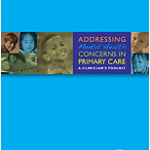In October, the journal Pediatrics, based right here in Vermont, published updated guidelines from the American Academy of Pediatrics (AAP) regarding the assessment and treatment of ADHD. 
Since its publication, what has clearly generated the most media discussion about these new guidelines is the inclusion of preschool children (age 4 and above) in the recommendations. The authors state that behavioral therapy should be the first line of treatment in preschoolers with ADHD, but their inclusion at all in the assessment and treatment recommendations has been problematic to some.
Perhaps overshadowed by the attention (no pun intended) paid to preschool ADHD is the position of the AAP that the diagnosis and treatment of ADHD, and other potential psychiatric comorbidities, should be squarely in the purview of primary care clinicians and not necessarily referred out for specialty care. The authors do introduce, as they say, some “intentional vagueness” in this area by stating that “the AAP acknowledges that some primary care clinicians might not be confident of their ability to successfully diagnose and treat ADHD in a child because of the child’s age, coexisting conditions, or other concerns. At any point at which a clinician feels that he or she is not adequately trained or is uncertain about making a diagnosis or continuing with treatment, a referral to a pediatric or mental health subspecialist should be made (pg5).” However, the sentence’s inclusion of potential reasons a referral would need to be made suggests that typically presenting ADHD would generally be expected to be handled in house.
Such a position has met some criticism from different angles, including a few within the psychiatric community who keep to the idea that ADHD, especially preschool ADHD, is beyond the limit of most primary care clinicians. In the article, the AAP acknowledges that the handling even of the initial assessment and management of ADHD would often require significant changes to most practices. The article refers readers to an AAP toolkit that is available and free to AAP members.
From my vantage point as a child psychiatrist who has reviewed close to 5000 consultation requests from the area to our outpatient clinic, it is clear that there is a tremendous amount of variability in the amount of workup that is done before a referral is made. When it comes to ADHD, we receive requests from pediatricians and family physicians who are asking us to take the very first step at evaluation and treatment, while there are others who ask for help only after they have already made a formal diagnosis and have unsuccessfully tried a number of interventions. Clinicians will always have different comfort levels with different types of problems. While some variability will always and probably should always exist, does our community need to do more to a) encourage and empower more primary care clinicians to try to take on ADHD themselves in a comprehensive way, b) spend its efforts on recruiting and retaining more mental health professionals to take on the task, or c) both?
Reference
Wolraich, M., Brown, L., Brown, R. T., DuPaul, G., Earls, M., Feldman, H. M., et al. (2011). ADHD: clinical practice guideline for the diagnosis, evaluation, and treatment of attention-deficit/hyperactivity disorder in children and adolescents. Pediatrics, 128(5), 1007-1022.
Tags: add, adhd, mental health, psychiatry

